Because I get a lot of questions about it…I thought I’d share about my process when backing and quilting Minky. I’m definitely not an expert but I’ve found what works best for me. I only attempt quilting them myself when they are a throw size or under…if I’m in a brave mood I might even try a twin size.
As I said in my Looking In post, I bought buy a lot of my Minky backings from my local Joanns, from here online (the cuddle dot is SO soft), and from here if I'm desperate when they go on sale (usually around $7-8 dollars a yard). Since some of them are 64" wide (check the listing before you buy), I can usually get away with only buying 2 to 2.5 yards and not piecing the back (throw size and under). I don’t pre-wash my Minky backs.
If I want a heavy quilt…especially if its going to be on a bed I add batting. If I want a lighter quilt for carrying around or for the couch I skip the batting. Double sided Minky Fleece is my favorite to use when I skip the batting (it’s a little thicker/fluffier), but it probably doesn’t matter. You can also use flannel to take the place of batting, especially if there is a lot of white in your top.
I pull out the big guns when I baste with Minky. I use basting spray heavily first, then I go back and also pin every 6-8". It’s probably overkill but it works. I tape the back to the floor when I baste…but be extra careful not to stretch it. Just get the wrinkles and creases out without pulling it tight.
Right after basting I stay-stitched around the edges using a long stitch length to keep everything in place. Once you get quilting the quilt can shift a lot and the edges tend to get stretched and wonky…I feel like it helps me free motion quilt nicely around the edges and everything stays nice and square.
If you notice the backing pulling through to the front in the stitches, try switching to a thinner needle. I usually use a size 90/10 (?) needle when I quilt…once I switched to a smaller size it stopped.
Using a large quilting design will keep your quilt from being too stiff and it will drape more like a cozy fleece throw. It will also prevent swear words from being said. :)
After I machine stitch the binding on it’s ready do be used and loved and fought over relentlessly!
That picture up there is before washing, but after washing it looked nearly the same with a tiny bit more "crinkle" in the top. Of course if you use batting, you’ll get a nice crinkly top, but a much stiffer quilt.
Feel free to share any other tips in the comments section…I’m sure we’d all love to read them!
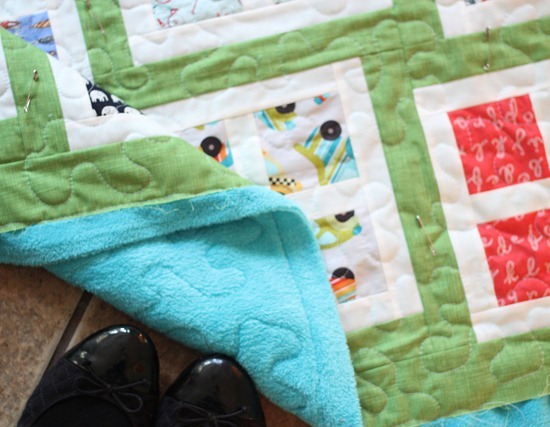

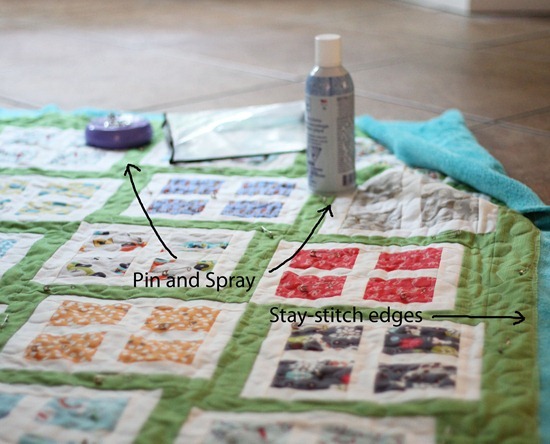
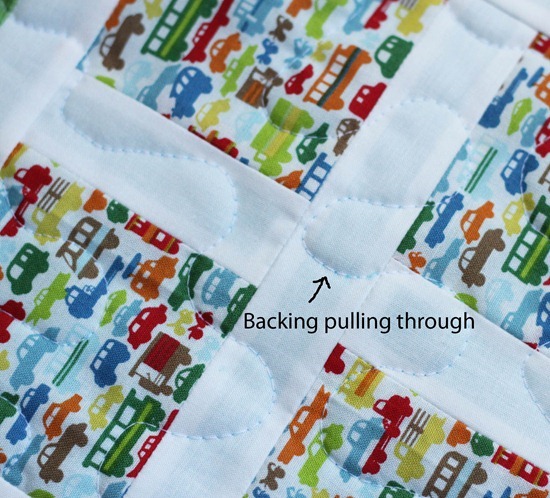
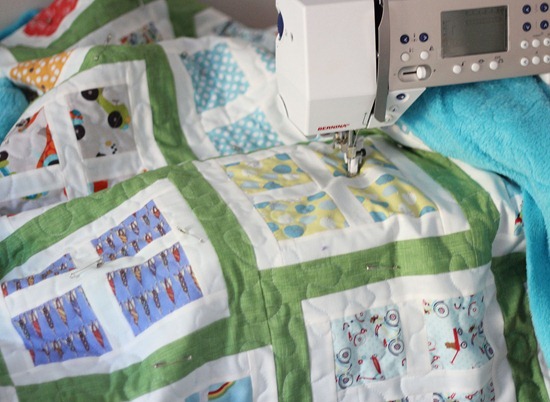
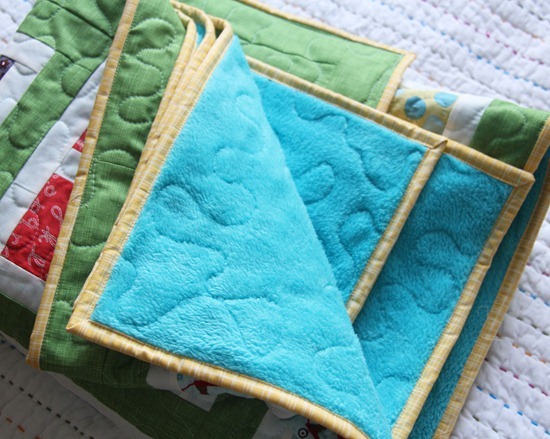
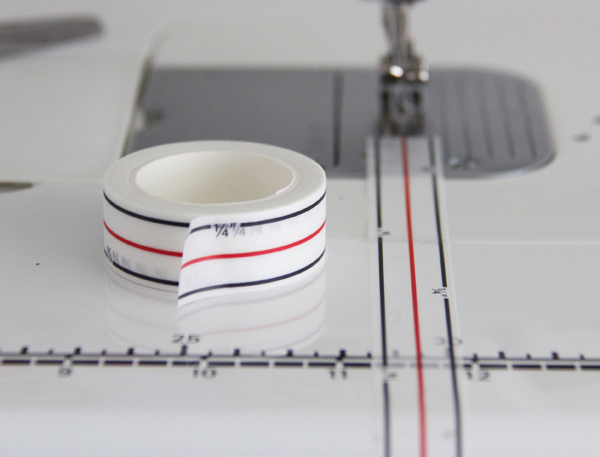
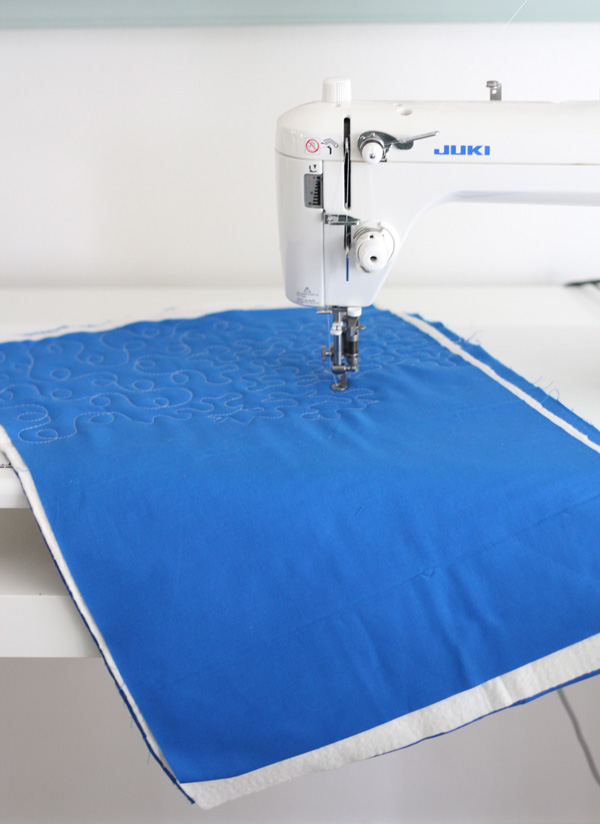
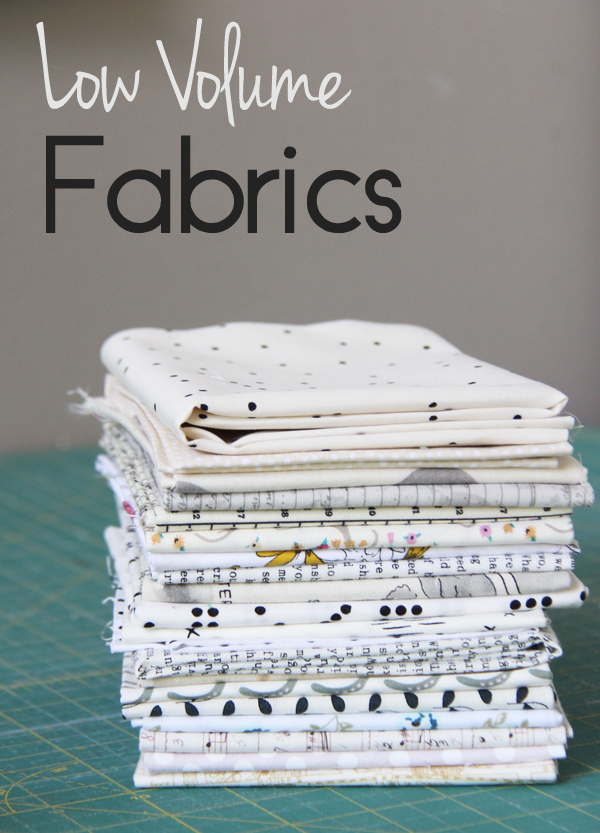
Laura @ ON{thelaundry}LINE
Thanks! Pinned it for later.
Svetlana
thanks for all the tips. I think it's such a great idea to use Minky for the backing, I used it for my son's quilt and I'm planning on using it again for some throw quilts.
Addie
Good information! Thank you!
Erica
Thanks for your post. I made a similar post on my blog the other day http://kitchentablequilting.blogspot.com/2012/10/my-thoughts-on-working-with-snuggles.html?m=0
Lisa
Thank you for a really useful post, Pinned it for future reference :)
Schulz Family
You make it look so straight forward and easy. I have hideous problems, but will use more basting spray and follow your tips. Thanks heaps
jules
Thanks so much for sharing these tips. I'm definitely going to try this for my next granddaughters quilt. It looks so soft and cuddly.
Yoga and Zumba® with Gaileee, E-RYT `n` Licensed Zumba® Instructor
Do you ever quilt as you go, a block at a time? Just curious!
Gaileee
Grandmasewnsew
Thank you for sharing this, it's on my to-do list! It also looks like you stitched down your binding. I guess it might not be too easy to hand sew it!
Katy
I've never quilted with minky, but I have sewn baby blankets with it and swear words can DEFINATELY be spoken. The way that stuff stretches and moves, especially when using regular cotton on top, can make me crazy. And every time I use it I swear *this* will be the last time. ;)
I read a tip of putting your minky and cotton on a carpeted floor - that will help it stay as you adjust and pin. And yes, pin every gosh darn inch and use 3,986 pins. But I will also have to spray it (even when not quilting) and that seem that will help a whole lot too! Thanks for the links and the tips!
Erika L.
I've successfully quilted (lap and smaller) with the really fuzzy minky. (e.g. http://farm6.staticflickr.com/5294/5390979204_2def26e84a_b.jpg) It hides the mistakes really well. I too have used batting and no-batting for making the quilts. I've only pinned, no glue or side stitching. I think the long length works well.
Anita
Thanks for the great tips!
Katie
I'm quilting two quilts with minky backing as we speak! I always use batting. . and baste with 2x4s (or 1x4s/sharon schamber method) Since it is stretchy, I would venture to guess that it would NOT work well with straight-line quilting. Wouldn't ya say? Only FMQ. .and like you, I only do a large-spaced stipple.
Peggy
Thanks for posting your tips on this! I just pinned a quilt that has a minky backing that looks fabulous but had me worried. How do you spray baste your quilts? It seems like it would be super messy and not something you'd want to get on anything else nearby.
cradke
I find the weight of quilting with minky (I do use batting) the difficult part - my poor shoulders! I don't spray baste, which is crazy - I just pin it to death and it always works out. Thanks for sharing your ideas - when I started quilting almost 2 years ago, there was no info on quilting with minky. I have never attempted free motion with minky - just lovely straight lines.
Kellie
Next quilt I start I'm going to try the double sided minky.... great reference Allison....
Hey you mentioned machine stitched binding.... I'd love for you to one day do a tutorial. Think about it?
Sara
I spray-basted Minky once with the June Taylor spray and after I washed the quilt the back was stuck to the batting kind of like static cling. I googled it and found that the spray sometimes has to be dry-cleaned out of polyester. Works wonderfully on cotton, but not Minky. I took the quilt to the dry-cleaner and they ironed it, permanently ruining the minky dots. Lesson learned for next time. The spray sure made Minky easier to work with though! Now I just pin the hell out of it and call it good.
Helen L
thanks for the info on using minky: I've been tempted to use it but have been too afraid to do so :-)
I love the spray baste too, but have used it on my largest floor space which is carpet and have found that there can be overspray and the carpet gets sticky :-P
Love your blog and the things you share with us: thanks so much!!! Helen in Healdsburg
Andrea
Thank you for sharing your process!
Lauren
Love this post. I made one small kids quilt with a Minky back and I have never tried it again.
As for spray basting - I'll never go back to any other method. I do spray baste on the living room floor but I spread sheets out to catch the over spray and then just throw them in the laundry when done.
Sheila
I made a minkee throw-sized quilt using the flip and sew method, so I didn't have to quilt it later. Used batting and more minkee for the back, pinned well (I don't have a well-ventilated space to use the basting spray) and sewed strips with larger stitch size. Even used minkee as binding! Came out great...you just have to watch the fabric nap, so they're going the direction you want them....
Heidi Barnard
Sheila - I want to use the backing minky for my binding. Do I need to cut binding strips vs. folding it over to the front (which I've seen done with cotton). I intend to have it long-armed. Thanks for any advice you can give, not a novice, but it's also been a while since I've had the luxury of enjoying quilting again. Thank you
jude
I have spray basted lots of quilts and found that if you use the 505 brand you will have a better result. It is also the most expensive, of course....have had bad luck with the June Tailor brand. If you lay down a thrift store sheet to catch the overspray, you will be fine.... It will wash out. The Dritz brand spray from Walmart is okay but not great with Minky...."stick" with 505. Hi Allison, miss you!
Coffee Break Whatever
I appreciate the info about batting and making a softer quilt.. I have been struggling with that for some time... I want a soft cuddly quilt, not a stiff one that doesn't even wrap around you!
Gayle
Thank you for these greats tips on using Minky. I have always been a bit afraid to try, but now I will certainly try it.
Tracy Johnson
Thanks for this tutorial. I had almost given up on using minke in my quilts. I (and my kids) love the feel, who doesn't.
LJ
I am not an expert but did just finish a baby quilt with Minkee on the back. I was worried but did some research online and at the LQSs. Spraying was mentioned again and again so I did spray with 505 and also pinned as with a regular quilt. I did straight-line quilting but used my dual-feed foot and it worked super slick! One other thing that many talked about was that the lint and ravels of Minkee were a nightmare. I decided to serge my raw edges as soon as I got it home; you could just use an overlock stitch on your regular machine. Every time there was a raw edge because of cutting the Minkee, I serged the edge. After the quilting was done, I even serged the raw edge around the quilt before I applied the binding. I'll definitely use Minkee again!
Jyoti Haeusler
Thanks for this post. I just had a disastrous time quilting with minky. I ended up pulling the quilt apart and going with cotton batting for the back. After that I decided to use the minky for binding but that didn't seem to work too well either. I have never used a spray basting technique, but I will definitely be trying this out next time!
Angie
Just a quick question--did you prewash your quilt top or quilt fabrics? I'm halfway through piecing a baby quilt top and decided to use a minky back after seeing your quilt and Faith's (Fresh Lemons Quilts), so am now wondering if I should prewash in case they shrink at different rates? Of course, I'd rather not. :-)
thepalmierifamily
My oldest child is on the autistic spectrum and he loves the soft backed blankets made with minky fabric, to the point that he's stolen his sister's blanket. I don't think it's as hard to use when you do smaller blankets. Thanks for all of the suggestions!
Melissa
This quilt is gorgeous! Wow, I want to learn how to make a quilt.
<3 Melissa
wildflwrchild.blogspot.com
Kathy Van Osdale
Great blog!
Rebecca Grace
I'm so glad you posted this? I quilted with Minkee twice, both times using a batting, and both times not 100% satisfied with results. First time, the quilt top was very simple 4" x 4" squares, prewashed fabrics, so I layered with a thin polyester batting, minkee backing, and tried "tying" the quilt with yarn French knots at the seam intersections. Well, even though I had prewashed the quilt top, it still shrank when the finished quilt was washed, and the batting did not, so the back of that quilt was like saggy, baggy elephant skin! The next time, I prewashed the quilt top fabrics, used a thin 100% cotton batting, FMQ quilted the snot out of just the quilt top and batting BEFORE layering the minkee backing on (NOT recommended -- uncovered cotton batting next to my feed dogs created lint of nightmare proportions!), and THEN I layered with the minkee backing and just did random eyelet circles throughout the quilt, every 4-6" or so, to hold the layers together. I still got some saggy baggy issues, and felt like I quilted too closely, making some parts of the quilt too stiff. I think next time I'll try basting with 505 as you suggest, maybe skip the batting to keep it soft, but most importantly I think your larger, more open quilting helps to make these very different fabrics come together and cooperate in a quilt, so I'll try that, too.
The only thing I did differently that I did like is that, since I only use Minkee backing for baby quilts, I like to use wide, pre-packaged satin binding for the edges instead of a traditional narrow quilt binding. I love how little ones will sit there and rub satin binding over their noses while they suck their thumbs, and it's a nice combination of textures to have the bumpy quilted cotton top, soft furry backing, and silky satin edges.
Thanks for sharing your method -- you get a bookmark from me! :-)
The Polka Dot Apron
Thank you so much for the fun idea! I actually stocked up on a huge variety of minky-type fleece blankets one year during an after-Christmas shopping 50% off sale and got YARDS AND YARDS of use-able fabric out of them! One throw was king sized and brown and doubled up so I could take off the ugly satin edge and pull the two sides apart giving me DOUBLE the fabric and the whole blanket was less than $5! I've used it for countless baby quilts and as tummies on stuffed animals, etc.
Andrea Turner
Thank you so much for this tutorial. I recently sent a larger quilt with minky backing to a friend to quilt, but am wanting to do a crib/lap sized quilt with the backing too. I'm so thrilled that I might be able to do this myself!
Vanessa D
I quilt with minky all the time for my business. I make changing pads. The type of minky you quilt with makes a BIG difference. Dimpled minky is the most common, but (I find) to be most problmatic. Try striped or vine embossed minky. They are premium fabrics so they cost a little more than JoAnn minky but the are SO MUCH SOFTER. They're great. Quilting with these, they stretch less and CAN BE IRONED. So, the issue Sara posted about in her trip to the dry cleaner, would have been avoided if she had used one of those. I also quilt in straight lines to form fold lines for my changing pads. The loft of your batting has a big impact on how much it shifts after basting and pinning. I use 1/4" loft currently but 1/8" in the past. I need the thicker loft, but the thinner one had less shifting. Stop by my blog or Etsy shop to see what those other minkys look like. http://www.SassySmidgens.Etsy.com.com
Heather A
I've found this post and the following comments very helpful but none address the particular problem I've been having with minky.
I've got the 505 spraying. Check. Works great. And I've pinned in addition to the spray. That holds things together nicely. I've used both batting and flannel between the layers and have liked both but because I've hand quilted the baby quilts I've made with perle cotton, it was sure a lot easier to do with the flannel in the middle instead of the batting. For hand quilting I would only use flannel for sure. The quilts I've done have washed up beautifully after hand quilting with no sags and that's without prewashing anything.
The problem that has me stumped is with machine quilting. You would think minky would glide across the surface but it just clings to my plexiglass surface table attached to my machine. I use the walking foot and I have to forced the quilt through, producing very uneven stitches and lots of wobbles. Things go better if I can create little air pockets before the quilt goes under the needle but that takes some wrangling and results in very wobbly lines.
This problem means I hand quilt baby quilts that have minky backings, which is my backing or choice for many quilts and if the quilts are larger, I send them to my long arm quilter who has no problem with the minky.
I would love to be able to straight-line quilt minky-backed quilts on my machine because the hand quilting is a very slow process for me. I have not yet progressed to fmq but have the slippy mat thing to attach to my plexiglass surface (for when I get up my nerve) but it doesn't work with the walking foot for straight line quilting.
Any suggestions would be appreciated.
Heather A
I will add that the problem with the minky and my sewing surface seems to be a build up of static. I tried washing the plexiglass and I tried a light coat of something ... I can't remember what it was but it was something that I wouldn't have to worry about getting on the fabric ... but it didn't make any difference for me.
It might make a difference if my machine was dropped into a table and I could have just a normal wood table surface. Is this the set-up everyone else has? I sew on my dining room table with a plexiglass surface which works like a charm for piecing and for quilting when I use cotton backs. Does anyone else use minky with a plexiglass surface?
Sarah
What amazes me about this post is that you don't have fuzzies all over the quilt before washing! As I've quilted my first minky backed quilt (5+ quilting sessions) the fuzzies have gradually gone down but I'm still lint rolling like crazy. My house looked like a fuzz bomb had gone off the first day! Any tips for managing the fuzz?!
Fran Gray
Heather A. - I haven't tried this yet but try adding tissue paper to your quilt sandwich behind the minky. It might make your needle dull more quickly but the quilt sandwich should glide across the sewing surface and it will probably help keep the minky from "crawling" too. Just tear off when you are done quilting.
mayamagic22
Hi Did you prewash the quilt top fabrics?while working with minky backing.
Amy
Great info! Thank you so much for posting it (4 years ago! haha.. I'm a little late to the party. lol)
I will be using Minky for the first time (and also basting spray, it seems) to make a blanket for a friends long awaied baby girl.. I will try to use all of your suggestions but I am still quite worried about the outcome of it.. The one thing people seem able to agree on is that Minky is tough to quilt! haha
technically I have never quilted anything, either.. (Hopefully by the time I make this I will have at least quilted the tote bag that I am currently working on..and Maybe I will have a clue..)
Anyway, thanks again! If you have any new tips, for a beginner, I would love to hear them! :D
kellmoony
I made a quilt kit that had two different minky fabrics sewn back to back... I love it but it is a little unwieldy without some quilting them together (scared!) -- It's probably full size bed size -- will pinning the daylights out of it be enough to keep it from bunching at the edges while I'm sewing? Hope i can find the best answer to my question somewhere - thanks for the tips on this page.
lpatealpine1222
I use minky on the back of almost all my quilts. My family and friends love the soft cuddly feel of this fabric. It is a wonderful way to finish off a quilt.